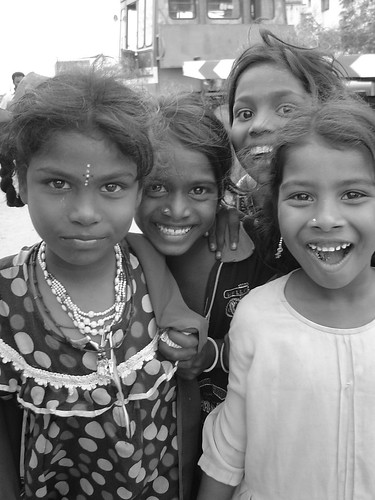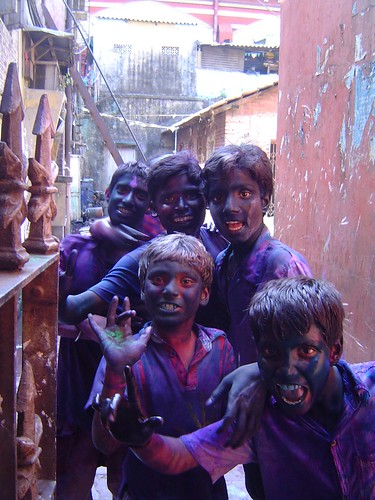several years ago i spent a few months in india doing tsunami relief work and traveling. i didn't realize i'd been bitten by the india bug until i moved back to my comfortable, yet predictable life in new york. it didn't take long for me to relocate to india full-time to try to make a life. now, after three years in mumbai, i split my time between america's east coast and india's west coast. the difference between life here and life there is that everything in india begs to be written about.
Thursday, May 26, 2005
Thank You

For nearly three weeks after I returned home from India, I awoke nightly thinking about everything I'd left behind. Even now, nearly two months out, India crosses my mind daily—luckily, not at 4 AM. Mostly, I think of the people I met, a girl named Susila, newly-orphaned Rahel, the wrinkled old fisherman; I recall their spirit and resiliency. That they now have a place in my memory is a gift, made possible by the generous support of family, friends and a few goodhearted strangers.
The money and support you provided helped the neediest and most deserving: survivors of the 2004 tsunami and Orissan orphans. The funds bought several hundred kilos of rice for an island community that had run out of food; supplied saris and lungis to several hundred women and men who had lost everything; gave 110 orphans coloring books, crayons, flashcards; and allowed me, as your representative, to act as a goodwill ambassador.
Thank you for your contribution—whether you attended the fundraiser, gave money, offered encouragement or lent emotional support. Your compassion enabled me to touch thousands, and for that I am forever grateful.
Annie, Ananda and the rest of the crew at Ara
Nabil Aidoud
Virginia Alexander
Pam Arthur
Kirk Bedell
Bryce Baradel
Jess Bolkcom
Caroline Boudreaux
Jen Branam
Mendy Brannon
Laura Brueck
Jen Bruno
Stacey Callahan
Matt Chapman
Mike Christopher
Hazel Clinton
Scot Clinton
Katy Daly
Jamie and Kevin Donner
Lauren Franzel
Vanessa Fontanez
Ali Froman
Kristen Gelder
Kate Golden
Hattie Grouber
Frank Griffiths
Gardner Harris
Audrey Hayden
Kara Hill
Alex Jaini
Lisa Jeffries
Jennifer Jones
Will Kain
Pam Kaupinen
Wes Kaupinen
Kendrick and Tracy
Kim, my dental hygienist
Megan Mann
Anna McDonald
Mimi Mayo
Jessica Meli
Lindsay Mendoza
Brooke Michael
Vanessa and Scott Myers
Narayanan P.R.
Carter Paine
Jay Patel
Jay Patel (there are two)
Kirin Patel
Caroline Puri
Dr. Kunal Puri
Dr. Richa Puri
Holly Reed
Les Rogers
Natalie Ryan
Alice Sarfati
Maziar Sassanpour
Shaolee Sen
Dr. Subroto Sircar
Alexis Tessier
Mary Ann Torrence
John Twomey
Jenny and Robbert Vorhoff
Whitney Watson
Pat Werblin
Saturday, May 07, 2005
Calcutta

“If you were a better liberal, you’d save that goat,” Pitt told me as we watched a diminutive, furry black goat receive a blessing of orange powder on his forehead in preparation for his impending sacrifice. I fiercely inhaled heavy air and wondered if I should leave. But, I couldn’t. There were two brown urchins holding onto my legs. I focused on their steaming little bodies holding tight to my legs, little tree huggers, and looked down into their laughing eyes. I tried to ignore the squalls of the goat. But, in retrospect, even if the babes hadn’t latched onto me, I wouldn’t have moved to save him. Instead, I came when Pitt motioned for me to watch from a better vantage point near him. And, steps from the chopping block, the energy building in crescendo, I winced as the goat came undone.
I felt strange about it afterwards—watching him die—so we left immediately, stepping over skinny women in wrinkled, cotton saris on the way out the temple gates. By this time, I had figured out that tickling the little leaches on my legs would make them release their grip, and forget about asking for rupees.
The heat combined with the smell of goat blood, which was all over the ground, along with the thwack of the scythe as it beheaded the goats was sensory overload. We left and went to the waterside for some air at Kalighat, a shrine-filled area with steps that lead down to the water. We were lucky there was no breeze that morning, because the river water was malodorous and filled with brown sludge and plastic trash. But, it was away from the Kali temple, where more than twenty goats had already been killed that morning, and more than twenty more would be killed before the sun reached its zenith.
From Kalighat, a word that a seafaring Brit is said to have mangled,
Calcutta, continued
If I made a diorama of Calcutta, and your eye peeked in and wandered over the temple scene, aghast, it would be all the more surprised by the scene outside of the temple, a couple of streets away, closer to the city center. Beautiful, old, decaying buildings rise up in faded brick red and mossy green, accented with thick wooden shutters, and latticed balconies. Echoing the chaos of
I wasn’t expecting the goat sacrifice, but then again, I wasn’t expecting a cosmopolitan place either. My mother loves to tell the story of her friend, a mature, single, well-traveled woman, who flew into
As culturally ignorant as it may sound, the only thing I have ever heard about Calcutta concerns its horror stories and unimaginable poverty. But, evidently,
At the start of the trip, I had decided that I would not be making the trek to
The trip from
Third class A/C was a complete revelation. We were given sheets, blankets, towels, a snack of cheese sandwich and mango juice, a nice vegetarian dinner, chai in our own thermos, and free bottled water. Every time the waiter appeared, he brought another surprise—biscuits? Ice cream? Fresh coffee? I had balked at the $38 train ticket—expensive for an
When the train pulled into the station, I galumphed off, an awkward llama with a heavy load, and was wholeheartedly greeted by
With the exception of the day of the goat sacrifice, I spent most of my time walking around and visiting some of
During my stay, I thought about Zana Briski’s Born Into Brothels, a documentary about the children of prostitutes in
_______________________________________________________

